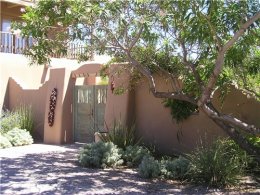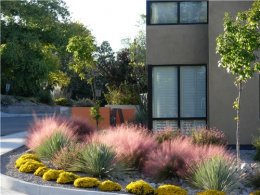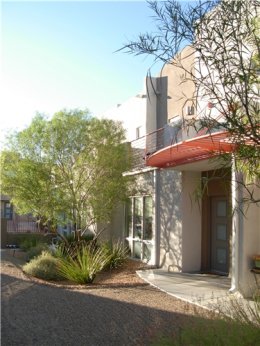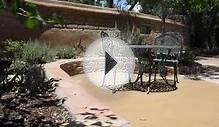

- Materials like stucco reflect a regional identity and look great next to Southwestern plants.
- Native and regionally-adapted plants create a sense of place in this Southwest landscape.
- Do create low areas in the landscape to plant trees. This allows any rainfall to flow where it's needed most.
- Designer David Cristiani of Quercus in Albuquerque, New Mexico.
Southwest Landscape Design
Use this design sheet to help you create the perfect Southwest landscape. You'll get ideas for color, décor, materials, plants and fabric. It is a great starting point for any New Mexico or Arizona landscaping project.
Southwest Landscape Design (PDF)
The Southwest is incredibly diverse, with different elevations and types of desert defining the landscape. Even so, themes like earth-colored stucco, shade ramadas, and plants like cactus, native yucca, and desert spoon give Southwest landscapes their unique character.
 You May Also Like:
You May Also Like:
David Cristiani of Quercus, a landscape architecture practice in Albuquerque, New Mexico, has over 20 years of experience designing for the different regions of the Southwest. Here are Cristiani's professional tips for creating a beautifully-designed Southwest landscape.
Dos:
- Do select native or well-adapted species that reflect the beauty of the region and will perform well with little water. Native plants like penstemon, agave, and mesquite add regional flair, while Mediterranean plants like rosemary, germander, and thyme also thrive under the hot sun.
- Do group plants according to their water needs. "You can't marry a North Carolina tree and an Arizona shrub, " says Cristiani. When plants are grouped by their water needs, it's easy to use different irrigation zones to water each type of plant appropriately.
- Do tailor your mulch selection to your plants. Desert natives with a finer leaf texture show up beautifully against gravel and grow well when mulched with it.
 Plants with larger leaves like roses, Indian hawthorn, or photinia are adapted to soil with more organic matter, so mulch them with a shredded cedar or cypress mulch.
Plants with larger leaves like roses, Indian hawthorn, or photinia are adapted to soil with more organic matter, so mulch them with a shredded cedar or cypress mulch. - Do create low areas in the landscape to plant trees. Since trees need more water to establish than do groundcovers and perennials, but are usually on similar hydrozones, this is an easy way of ensuring that any excess water naturally flows where it's needed most.
Don'ts:
- Don't landscape with all rocks. While rocks are certainly low-maintenance, they become so hot and bright in the sun that the landscaping can become unpleasant to live with, or look at. As Cristiani points out, "Who wants to live in the bottom of a terrarium?"
- Don't start with mature specimen trees, unless local codes require this. A young 5-gallon tree will need less water to establish than a 48" boxed specimen, and it will grow to the same size within five years.
- Don't use water-hogging plants like queen palm, cottonwood, willow, sycamore, aspen, ash, Bradford pear, or purple-leaf plums. All of these species need either heavy irrigation, richer soils, or humidity to be happy, and simply don't perform well in the Southwest.
- Don't overwater. "Water can be a life-giver or an herbicide, " says Cristiani. Within one to two years, transition all plants to deep, infrequent watering. Watering deeply every two weeks in summer and once a month in winter is just right for the Southwest.
 Cristiani feels that a strong regional identity is key in successful design. As he says on his website, "The built landscape should do justice to the adjacent natural landscape; not be Anytown, USA. Embracing one's sense-of-place is why landscape architecture is vital to our quality of life in the high desert." While Cristiani has lived in a variety of places, he chose to settle in the Southwest because as an architect, he felt drawn to the potential of creating that strong sense of regional identity there.
Cristiani feels that a strong regional identity is key in successful design. As he says on his website, "The built landscape should do justice to the adjacent natural landscape; not be Anytown, USA. Embracing one's sense-of-place is why landscape architecture is vital to our quality of life in the high desert." While Cristiani has lived in a variety of places, he chose to settle in the Southwest because as an architect, he felt drawn to the potential of creating that strong sense of regional identity there.
To help his landscapes reflect a sense of place, Cristiani uses materials like tile, stucco (earth-toned or brightly-colored), plaster, modular pavers, and metals like steel or tin. Rustic wood is another material commonly used in the region, and mortared rock can be used in walls to create interest. He draws inspiration not only from his surroundings in the Southwest, but from similar climates in dry regions of the Mediterranean, Africa, or Australia.
Quercus
Albuquerque, NM
Get design ideas for modern, tropical, Mediterranean, traditional, country & desert gardens
YOU MIGHT ALSO LIKE












